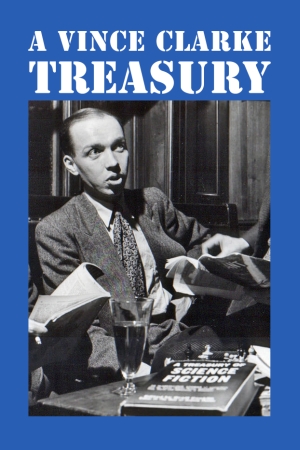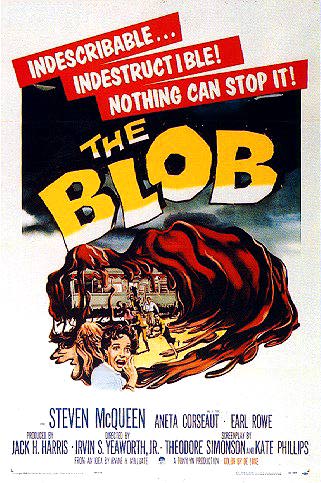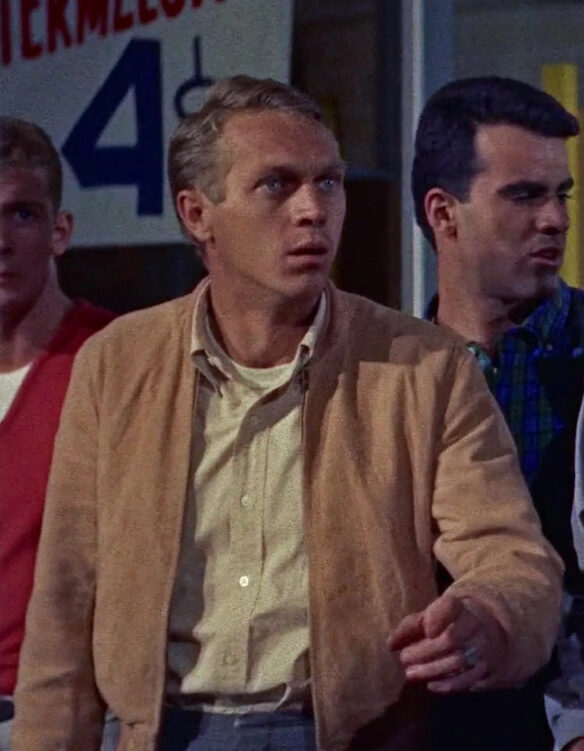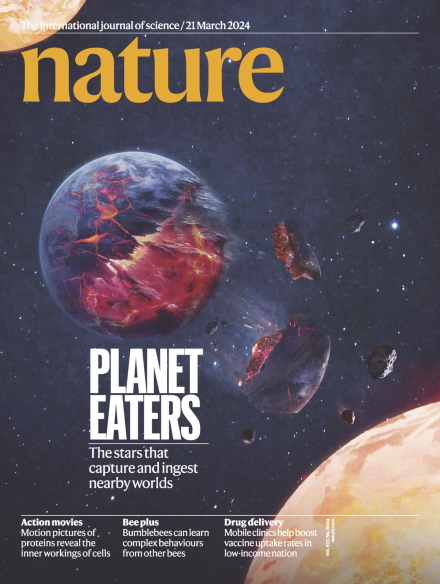(1) NORTHUMBERLAND HEATH SF HAD ITS MONTHLY MEET. [Item by SF Concatenation’s Jonathan Cowie.] No big deal in itself but the meet saw Nicki receive a copy of her father’s collected fan writings: A Vince Clarke Treasury.

Vince, of course, being a long-standing BritCit fan from the days of Ken Bulmer, Tedd Tubb and — no relation – Arthur C. Clarke. Vince was GoH at the 1995 Glasgow Worldcon, Intersection. Here’s Vince’s conreport. (Click for larger image.)

(2) O CAPTAIN, MY CAPTAIN. “William Shatner: ‘Good science fiction is humanity, moved into a different milieu’” – so he tells a Guardian interviewer.
…In the case of his time on Star Trek, for instance, an inevitable subject of discussion with the former Captain Kirk: “It was three years of my life, you know?” It gladdens him to see how much joy the series has brought its many fans, but the richest rewards came in his introduction to science fiction, which activated and nurtured a lifelong curiosity about our species. He reminisces about meeting the great writers of the genre fondly yet frankly, honest enough to sort Ray Bradbury into “the category right below friend, I think”. He devoured their novels and developed a fascination with the principle of defamiliarization, that concepts taken for granted can be understood anew when viewed through the vantage of a stranger in a strange land. “Good science fiction is humanity, moved into a different milieu,” he says. “Great stories are great stories. You put human beings on a spaceship or a deserted planet, and we’ve got another way to see ourselves.”…
(3) KAIJU AROUND THE CLOCK. Collider tells where you can “Celebrate Godzilla’s 70th Birthday Party with a 24-Hour Franchise Marathon”.
… the Music Box Theatre in Chicago is hosting a 24-hour Godzilla marathon in June as a part of an almost week-long event.
From June 7 to June 13, 2024, the Music Box Theatre has partnered with the Japanese Art Foundation to host a slew of events in honor of Godzilla’s historic reign. Opening night (June 7) will be a double feature of the last two Toho Godzilla films, Shin Godzilla and Godzilla Minus One. This is followed by a panel discussion entitled “Godzilla: The Atomic Age Anti-Hero” led by Saira Chambers of the Japanese Culture Center/Japanese Arts Foundation and Dr.Yuki Miyamoto of DePaul Humanities Center. June 8 is when the 24-hour Godzilla marathon will be taking place. This will feature 15 films from the character’s Showa-era. Then, June 9, a rare I.B. Technicolor 35mm print screening of the underrated Godzilla (1998) starring Matthew Broderick will be shown. Other screenings that will be shown throughout this monstrous event will include the original Godzilla from 1954, The Return of Godzilla, and Godzilla vs Biollante.
(4) 2024 WATERSTONES CHILDREN’S BOOK PRIZE. “Botanical fairytale set in Kew Gardens wins the Waterstones children’s book prize” reports The Guardian.
Kew Gardens features a hidden magical door in the winning book for this year’s £5,000 Waterstoneschildren’s book prize.
Greenwild: The World Behind the Door by Pari Thomson was voted the winner by Waterstones booksellers. The book “is a spellbinding triumph that will make children fall in love with the world they are reading about, and with reading itself,” said Bea Carvalho, head of books at Waterstones.
The book follows Daisy as she searches for her missing mother and discovers another world behind a hidden doorway in Kew Gardens. She soon learns that the new realm, filled with plants and magic, is under threat, and she bands together with a botanical expert, a boy who can talk to animals and a cat to save the green paradise.
Thomson lives near Kew Gardens – a place “full of sparkling glasshouses and carnivorous plants and lily pads big enough to take a nap on”, she said. “I have always felt that nature was a little bit magic – and Kew made me ask, what if it was true? What if the natural world all around us was brimming with magic? Greenwild is the answer to that question.”…
(5) TODAY’S BIRTHDAY.
[Written by Cat Eldridge.]
Born March 24, 1930 – Steve McQueen. (Died 1980.) I know that Steve McQueen had but one SF role as Steve Andrews in The Blob. He received three thousand dollars in the late Fifties for that his first starring role, now thirty thousand if it was adjusted for inflation.

He had turned down a first offer for a much smaller up-front fee in return for a ten percent share of profits, thinking the film would never make money, a reasonable assumption on his part.
As later biographies noted, he needed this money immediately to pay for food and rent. However, this film ended up being a major hit, grossing four million at the box office after costing just one hundred and ten thousand to make, ten thousand under budget.
I’ve seen it and he was quite excellent in it. Certainly I think he did better than the reviews of the time indicated such as the New York Times which said “the acting is pretty terrible” and or the Variety that proclaimed, “Neither the acting nor direction is particularly creditable.” Humph.


So one genre film, right? Now let’s look at what else that I like that he was in.
Two years later, he’d be in The Magnificent Seven. Yes, it’s a remake of a Japanese film but it feels all American. And the cast, oh my — other performers included Yul Brynner, Charles Bronson, Robert Vaughn and James Coburn. It’s considered one of the greatest films of the Western genre and deservedly so.
The Thomas Crown Affair, released a decade later, was a most extraordinary heist film that he headed with Faye Dunaway. The perfect crime takes place. And then again and possibly deadly consequences. Oh it’s wonderful. He’s definitely a much better performer here, not surprising really.
Now let’s see… Anything else? Yes, one last film worth, in my opinion to note.
He’s the lead in The Great Escape as Captain Virgil Hilts which tells the story of the escape by British prisoners of war from German POW camp Stalag Luft III. Well, a highly fictional version of course.
(6) COMICS SECTION.
- Candorville explains once again that sf jokes are hard.
- Tom Gauld presents a double feature.
(7) GENTLEBEINGS, BE SEATED. At Sci-Fi World Museum in Santa Monica, CA, “The restored Star Trek Enterprise-D bridge goes on display in May” – Ars Technica has the story.
More than a decade has gone by since three Star Trek: The Next Generation fans first decided to restore the bridge from the Enterprise-D. Plans for the restored bridge morphed from opening it up to non-commercial uses like weddings or educational events into a fully fledged museum, and now that museum is almost ready to open. Backers of the project on Kickstarter have been notified that Sci-Fi World Museum will open to them in Santa Monica, California, on May 27, with general admission beginning in June.
It’s not actually the original set from TNG, as that was destroyed while filming Star Trek: Generations, when the saucer section crash-lands on Veridian III. But three replicas were made, overseen by Michael Okuda and Herman Zimmerman, the show’s set designers. Two of those welcomed Trekkies at Star Trek: The Experience, an attraction in Las Vegas until it closed in 2008.
The third spent time in Hollywood, then traveled to Europe and Asia for Star Trek: World Tour before it ended up languishing in a warehouse in Long Beach. It’s this third globe-trotting Enterprise-D bridge that—like the grit that gets an oyster to create a pearl—now finds a science-fiction museum accreted around it. Well, mostly—the chairs used by Riker, Troi, Data, and some other bits were salvaged from the Las Vegas exhibit….
(8) TWO THUMBS. Collider remembers “The Time Roger Ebert and Gene Siskel Stood Up For Star Wars”.
…[John] Simon’s opinion is highly unusual, as most critics who have reviewed the original Star Wars films are generally complimentary of the visual effects, which are often praised as being extremely convincing and for blending practical techniques with computer-generated work. For example, in his original review of Return of the Jedi for The Chicago Tribune, Siskel remarked that, “for the professional moviegoers, it is particularly enjoyable to watch every facet of filmmaking at its best.” In their response to Simon, Ebert disagreed with the idea of the prominence of the special effects being indicative of poor quality, saying, “I think all movies are special effects. Movies are not real. They are two-dimensional. It’s a dream. It’s an imagination,” alluding to the idea that since all films are brought to life with a combination of effects, what matters is whether said effects work in convincing ways and immerse viewers in a given story….
(9) BANG THE GAVEL SLOWLY. Then in the present, Judge John Hodgman has been called on to remedy a genre-related dispute: “My 60-Year-Old Brother has Never Seen ‘Star Wars.’ Help!” in the New York Times. Here’s the problem – see the answer at the link.
Erin writes: My brother Joel is 60, and I’m 52. But despite growing up in the ’70s, Joel never saw the original “Star Wars.” Now he refuses to, because “sci-fi is dumb.” Please order that he watch it with me on his next visit. I will even provide the gummies if needed!…
(10) BURRRP! [Item by SF Concatenation’s Jonathan Cowie.] Nature has a cover with a decidedly SFnal theme about stars that destroy worlds. ‘Death Stars’ if you will….
The cover shows an artist’s impression of a planet being captured and ingested by one of the stars in co-moving pairs of stars. In this week’s issue, Fan Liu and colleagues present evidence suggesting about 1 in 12 stars might have ingested a planet. The chemical composition of a star can change when it engulfs a planet, so the researchers looked at binary star systems in which the two stars were born at the same time. By comparing the spectral signatures of the stellar twins, they were able to identify instances in which one of the stars had ingested a planet. They identified 91 pairs of close ‘co-natal’ stars and found evidence of planetary ingestion in about 8% of them.

(11) HORSES FOR COURSES? HANDICAPPING THE ECLIPSE. Atlas Obscura tells how “Eclipse Maps Entered a Golden Age Thanks to Edmond Halley”.
In 1715, Edmond Halley published a map predicting the time and path of a coming solar eclipse. Today the astronomer is most famous for understanding the behavior of the comet now named for him, but in his lifetime he was a hotshot academic, elected to the Royal Society at age 22 and appointed the second Astronomer Royal in 1720. He was fascinated with the movements of celestial bodies, and he wanted to show the public that the coming event was not a portent of doom, but a natural wonder….
… With each eclipse to pass over the British Isles, publishers became more savvy about promoting the event to the public. In 1737, mathematician and astronomer George Smith published a predictive eclipse map in The Gentleman’s Magazine, which is thought to be the first eclipse map published in a popular publication (as opposed to as a stand-alone broadside). By 1764, wrote historian Alice N. Walters in a 1999 paper published in History of Science, “so many eclipse maps were on the market—each with a different prediction—that one commentator likened the competition between them and their producers to an event quite familiar to the English public: a horse race.”…
(12) A DAYTIME VISIBLE NOVA. Another predictable but even rarer celestial event is coming up soon: “Stellar explosion: What to know about T Coronae Borealis nova” at Yahoo!
…It’s not exactly new but there will be an extra star in the sky that will be visible to the naked eye in the coming months in Northern California. T Coronae Borealis is a binary star system comprised of a cool red giant and a hot white dwarf star 3,000 light years away. The smaller white dwarf has been stealing matter from the red giant and appears to be getting ready to emit a burst of energy which will make it visible for at least a few days. It is known as a recurring nova where matter, mostly hydrogen, is collected by the white dwarf until enough mass is reached, creating a fusion reaction. That will then emits a burst of energy, which includes visible light. This process has been going on for a long time and occurs about every 80 years in this system….
(13) AS THE WORM TURNS. And one more reason to keep watching the skies – “Here’s how to see the upcoming worm moon lunar eclipse”
A glowing worm moon will light up the sky on Monday with a celestial performance in store for people venturing out in the early morning hours — a penumbral lunar eclipse.
March’s full moon, referred to as the worm moon by the Farmers’ Almanac due to its proximity to the spring equinox, will be at its fullest at 3 a.m. ET.
A few hours earlier, starting at 12:53 a.m. ET, according to EarthSky, the moon will be almost perfectly aligned with the sun and Earth, causing the outer edge of Earth’s shadow, known as the penumbra, to be cast onto the glowing orb.
The greatest eclipse will be at 3:12 a.m. ET, when the moon will appear to be slightly darker than usual, said Dr. Shannon Schmoll, director of the Abrams Planetarium at Michigan State University….
[Thanks to Cat Eldridge, SF Concatenation’s Jonathan Cowie, Steven French, Kathy Sullivan, Mike Kennedy, Andrew Porter, John King Tarpinian, and Chris Barkley for some of these stories. Title credit belongs to File 770 contributing editor of the day Soon Lee.]
